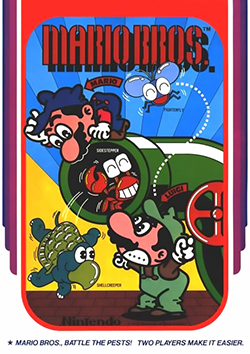
Mario Bros. is a platform game developed and published by Nintendo as an arcade video game in 1983. It was designed by Shigeru Miyamoto and Gunpei Yokoi, Nintendo's chief engineer. Italian twin brother plumbers Mario and Luigi exterminate creatures, like turtles (Koopas) and crabs emerging from the sewers by knocking them upside-down and kicking them away. The Famicom/Nintendo Entertainment System version is the first game produced by Intelligent Systems. It is part of the Mario franchise, but originally began as a spin-off from the Donkey Kong series.

Super Mario World 2: Yoshi's Island is a 1995 platform game developed and published by Nintendo for the Super Nintendo Entertainment System (SNES). It is the sequel follow-up to Super Mario World. The player controls Yoshi, a friendly dinosaur, on a quest to reunite baby Mario with his brother Luigi, who has been kidnapped by Kamek. As a Super Mario series platformer, Yoshi runs and jumps to reach the end of the level while solving puzzles and collecting items with Mario's help. The game has a hand-drawn aesthetic and was the first in the franchise to have Yoshi as its main character, where it introduces his signature flutter jump and egg spawning abilities.

Super Mario Bros. 2 is a platform game developed and published by Nintendo for the Nintendo Entertainment System. It was first released in North America in September 1988, and in the PAL region in 1989.

Super Mario Bros.: The Lost Levels is a 1986 platform game developed by Nintendo R&D4 and published by Nintendo. A sequel to Super Mario Bros. (1985), the game was originally released in Japan for the Family Computer Disk System as Super Mario Bros. 2 on June 3, 1986. Nintendo of America deemed it too difficult for its North American audience and instead released an alternative sequel, also titled Super Mario Bros. 2, in 1988. The game was renamed The Lost Levels and first released internationally in the 1993 Super Nintendo Entertainment System compilation Super Mario All-Stars. The game has since been ported to the Game Boy Color and Game Boy Advance, along with being re-released through emulation for the Wii, Wii U, Nintendo 3DS, and Nintendo Switch.

Super Mario Land is a 1989 platform video game developed and published by Nintendo as a launch game for its Game Boy handheld game console. It is the first Mario platform game to have been released for a handheld console. In gameplay similar to that of the 1985 Super Mario Bros., but resized for the smaller device's screen, the player advances Mario to the end of 12 levels by moving to the right and jumping across platforms to avoid enemies and pitfalls. Unlike the other Mario games, Super Mario Land is set in Sarasaland, a new environment depicted in line art, and Mario pursues the debuting Princess Daisy. The game has two Gradius-style shooter levels.
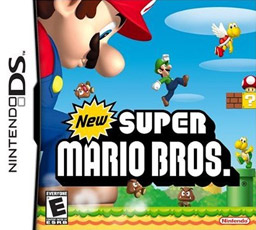
New Super Mario Bros. is a 2006 platform game developed and published by Nintendo for the Nintendo DS. It was first released in May 2006 in North America and Japan, and in PAL regions in June 2006. It is the first installment in the New Super Mario Bros. subseries of the Super Mario franchise, and follows Mario as he fights his way through Bowser's henchmen to rescue Princess Peach. Mario has access to several old and new power-ups that help him complete his quest, including the Super Mushroom, the Fire Flower, and the Super Star, each giving him unique abilities. While traveling through eight worlds with more than 80 levels, Mario must defeat Bowser Jr. and Bowser before saving Princess Peach.

Super Princess Peach is a platform video game developed by Tose and published by Nintendo for the Nintendo DS. It was released in Japan in October 2005 and worldwide the following year. Super Princess Peach is the first game to feature Princess Peach as the main protagonist on a dedicated video game console and the second overall after Princess Toadstool's Castle Run released in 1990 on the Nelsonic Game Watch.

Super Mario is a platform game series created by Nintendo starring their mascot, Mario. It is the central series of the greater Mario franchise. At least one Super Mario game has been released for every major Nintendo video game console. However, there have also been a number of Super Mario video games released on non-Nintendo gaming platforms. There are more than 20 games in the series.

Mario is a Japanese multimedia franchise created by Japanese game designer Shigeru Miyamoto for video game company Nintendo which produces and publishes its installments. Starring the titular Italian plumber Mario, it is primarily a video game franchise, but has extended to other forms of media, including television series, comic books, a 1993 feature film, a 2023 animated film and theme park attractions. The series' first installment was 1983's Mario Bros., although Mario had made his first appearance in 1981's arcade game Donkey Kong, and had already been featured in several games of the Donkey Kong and Game & Watch series. The Mario games have been developed by a wide variety of developers including Nintendo, Hudson Soft, and AlphaDream. Mario games have been released almost exclusively for Nintendo's various video game consoles and handhelds, from the third generation onward.

New Super Mario Bros. Wii is a 2009 platform game developed and published by Nintendo for the Wii. A follow-up to New Super Mario Bros., it was first released in Australia, North America, and Europe in November 2009, followed by Japan a month later. A high-definition port for the Nvidia Shield TV was released in China in December 2017. Like other side-scrolling Super Mario games, the player controls Mario as he travels eight worlds and fights Bowser's henchmen to rescue Princess Peach. New Super Mario Bros. Wii was the first Super Mario game to feature simultaneous cooperative multiplayer gameplay; up to four people can play in cooperative and competitive multiplayer modes, taking control of Mario as well as Luigi and one of two multicolored Toads. The game also introduces "Super Guide", which allows the player to watch a computer-controlled character complete a level.

New Super Mario Bros. U is a 2012 platform game developed and published by Nintendo as a launch title for the Wii U. The game is a sequel to New Super Mario Bros. Wii and is the first entry in the Super Mario series to feature high-definition graphics.

Super Mario All-Stars is a 1993 compilation of platform games for the Super Nintendo Entertainment System (SNES). It contains remakes of Nintendo's four Super Mario games released for the Nintendo Entertainment System (NES) and the Famicom Disk System: Super Mario Bros. (1985), Super Mario Bros.: The Lost Levels (1986), Super Mario Bros. 2 (1988), and Super Mario Bros. 3 (1988). As in the original games, players control the Italian plumber Mario and his brother Luigi through themed worlds, collecting power-ups, avoiding obstacles, and finding secrets. The remakes feature updated graphics—including the addition of parallax scrolling—and music, modified game physics, a save feature, and bug fixes.

New Super Mario Bros. 2 is a 2012 platform game developed by Nintendo EAD Group No. 4 and published by Nintendo for its Nintendo 3DS handheld video game console, being first released in Japan on July 28. It is a direct sequel to the 2006 Nintendo DS game New Super Mario Bros. and is the first Nintendo-published game to be released simultaneously in both downloadable and physical forms.
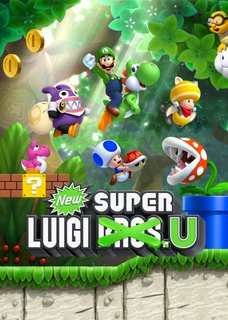
New Super Luigi U is a 2013 platform game developed by Nintendo for the Wii U. It is an expansion pack for New Super Mario Bros. U (2012), part of the Super Mario series. The plot and game mechanics remain identical to New Super Mario Bros. U, but Luigi replaces Mario as the protagonist. Luigi jumps higher and has less ground friction than Mario, and every level is redesigned to increase the difficulty level. The expansion adds Nabbit, a non-player character from New Super Mario Bros. U, as an invincible playable character.
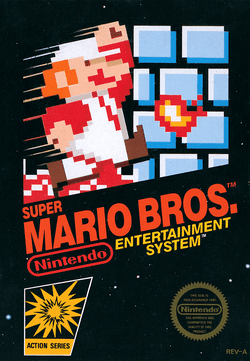
Super Mario Bros. is a platform game developed and published in 1985 by Nintendo for the Famicom in Japan and for the Nintendo Entertainment System (NES) in North America. It is the successor to the 1983 arcade game Mario Bros. and the first game in the Super Mario series. Following a US test market release for the NES, it was converted to international arcades on the Nintendo VS. System in early 1986. The NES version received a wide release in North America that year and in PAL regions in 1987.

Super Mario Maker 2 is a 2019 platform game and game creation system developed and published by Nintendo for the Nintendo Switch. It is the sequel to Super Mario Maker and was released worldwide on June 28, 2019. The gameplay is largely retained from that of its predecessor, in which players create their own custom courses using assets from various games across the Super Mario franchise and share them online. Super Mario Maker 2 introduces new features and course assets, including a single player story mode and new level assets based on Super Mario 3D World.

Game & Watch: Super Mario Bros. is a limited-edition Game & Watch system developed and published by Nintendo, released on November 13, 2020. The system features three Nintendo games: Super Mario Bros. (1985), Super Mario Bros.: The Lost Levels (1986), and a Mario-themed version of Ball (1980). The system was released for the 35th anniversary of the Super Mario series and the 40th anniversary of the Game & Watch line.
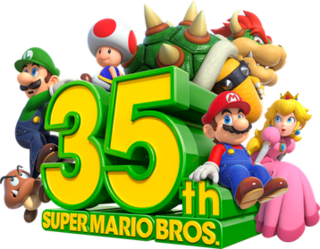
The Super Mario Bros. 35th Anniversary was a celebration of the Super Mario video game series created by Shigeru Miyamoto. The series began with the release of Super Mario Bros. on September 13, 1985, and has since spanned over twenty games appearing on every major Nintendo video game console. Through a series of leaks initially reported by Video Games Chronicle in March 2020, plans revealed that Nintendo originally planned to celebrate the anniversary earlier in 2020; however, due to the COVID-19 pandemic, the anniversary was postponed to September that same year. The anniversary was announced in a Nintendo Direct on September 3, 2020, and ran until March 31, 2021.

Pac-Man 99 was a maze video game with battle royale elements developed by Arika and published by Bandai Namco Entertainment for the Nintendo Switch. It was released through the Nintendo Switch Online service on April 7, 2021.




















